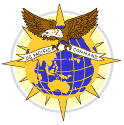Index | Search |





|
Planning a Block II Tomahawk mission is an extensive process. All Block II Tomahawk missions are currently planned at two land-based facilities or Cruise Missile Support Activities (CMSA), located at Headquarters, U.S. Pacific and Atlantic Commands. Targeting for TOMAHAWK is supported by the Theater Mission Planning Center and by the Over-the-Horizon Detection, Classification, and Targeting System. During the mission planning process, planners must identify a route extending from a fixed starting point to the target. The route must be within the missiles' range, must not contain any obstacles to its flight such as steep mountains or concentrations of enemy air defenses, and must pass over terrain that would allow planners to prepare usable Terrain Contour Matching (TERCOM) maps and Digital Scene Mapping and Area Correlation (DSMAC) images. Planners must also identify specific aim points on the target whose destruction will achieve the desired military effect. Finally, planners must select a terminal maneuver--the manner in which the missile impacts the aim point--and the number of missiles needed to achieve the desired level of destruction.
The Block II missiles' need for TERCOM maps and DSMAC images significantly affects the planning process. The preparation of a TERCOM map requires high-quality geographic data of specific terrain features that meet stringent requirements for changes in elevation. The DSMAC process requires imagery of the intended scene that provides a specified range of contrast. Since the contrast of a ground scene can vary between night and day or with the changing seasons, the imagery must be specific to those conditions. The scene's precise geographic location must also be known. CMSAs obtain the TERCOM data from the National Imagery and Mapping Agency, and a variety of intelligence activities provide the images CMSAs use to prepare the DSMAC scenes. The entire planning process for the Block II system, if the TERCOM and DSMAC data is readily available, takes from 24 to 80 hours. If the required imagery is not readily available, Tomahawk mission planning can be delayed until the imagery is procured. Navy officials noted that this delay occurred during Desert Storm.
Planned missions are transferred to the Tomahawk-capable ship or submarine either through delivery of a data transport device (which is a large computer disk) or through radio communications channels. Once a ship or submarine is tasked to launch a Tomahawk, the process on board the launching vessel involves powering up the missile, aligning its inertial navigation equipment, transferring the mission into the missile's computer, and then launching the missile.
The CMSA includes a Tactical Data Processor (TDP) in the The Tactical Data Information Exchange Subsystem (TADIXS), which is designed to support the exchange of Over-The-Horizon Targeting (OTH-T) information between shore and fleet-based computer systems, as well as in the Officer in Tactical Command Information Exchange Subsystem (OTCIXS). In TADIXS, the CMSA primarily operates in a transmit mode, broadcasting data to fleet users. In OTCIXS, the CMSA primarily operates in a receive-only mode to accept command/control and surveillance information from afloat TDP systems for track correlation and generation purposes. The CMSA site is provided with a Tactical Data Processor Controller (TDPCON) for connectivity with the local TADIXS Gateway Facilities (TGFs) which are located at the four NCTAMS at Norfolk, VA; Bagnoli, Italy; Wahiawa, HI; and Finegayan, Guam; and at the Naval Computing and Telecommunications Station (NCTS) in Stockton, CA. The TGF performs routing services and provide satellite access to TADIXS and OTCIXS.
One of the most significant improvements to the Block III missile is its added ability to navigate to targets using the Global Positioning System (GPS). GPS navigation frees the Tomahawk from having to fly over terrain that is suitable for and has been mapped for TERCOM navigation. Guiding from the signals of GPS satellites, a Block III missile can approach the target area from any direction and needs only to fly over one terminal DSMAC scene to achieve its full accuracy. The missile retains its ability to navigate to the target area with the TERCOM/DSMAC system.
Mission planning improvements will shorten the planning process. The improvements, which are in place and operational at CMSAs, include new software and workstations that automate many of the Tomahawk's mission planning tasks. As a result, according to Navy officials, missions using TERCOM maps and DSMAC scenes can be planned in 90 percent less time, with potentially fewer human errors. The flexibility to configure missions using only GPS to navigate to the target area and one terminal DSMAC scene, if the DSMAC imagery is available, will further reduce mission planning time by more than 60 percent. Additionally, Navy officials said that missions using only GPS to navigate could be planned in even shorter periods.
Block III upgrades are compatible with the Block II missile. Block III missiles can utilize Block II TERCOM/DSMAC missions and retain such benefits as the Block III's increased range and more lethal warhead. Both CMSAs will continue to plan Block II missions to support the Block II missiles that will remain in the inventory.TALKING POINTS FOR Silent Fury IN FBE BRAVO In the Fall of 1996 CMSAPAC participated in the Silent Fury excercise, looking at the Targeting Process required to get very accurate aimpoints (Desired Points of Impact (DPIs)) to the shooter. DPIs (NOT Desired Mean Point of Impact (DMPI)) is a new term, and is required to differentiate between a coordinate that is currently expected to be accurate +/- XXX feet (DMPI) and a coordinate that needs to be accurate +/- YY feet (DPI). This new level of accuracy is required to employ GPS Guided Munitions (GGMs). GGMs can be delivered in all weather because the shooter doesn't have to see the target, which is a whole new way to fight. GGMs include JSOW, JDAM, TLAM, ERGMs, ATACMs and SLAM. All of these weapons require very accurate GPS coordinates.
The national architecture of organizations that have the ability to produce DPIs includes NIMA, CMSALANT and CMSAPAC. The Navy has an organic capability to produce DPIs with the Afloat Planning System used for TLAM planning. The Navy can fly 200 strike sorties in a day and an F/A-18 can carry 4 JDAM/JSOW. When combined with the possibility of firing hundreds of TLAM and ERGMs from the CVBG ships, this will generate requirements for large numbers of DPIs to meet our large strike capability, which in turn creates a requirement to task the national architecture as well as the organic capabilities.The Silent Fury exercise looked at the tasking process, concentrating first on the measured accuracy that each organization can provide, second, the volume of DPIs that can be produced and finally, the speed that the architecture can respond to the tasking.
